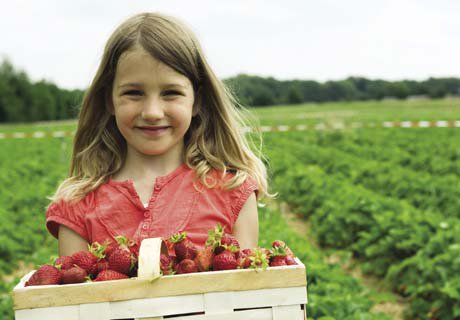
CSA girl with strawberries
Spring is right around the corner so now is the perfect time to get in on a CSA (community supported agriculture). Below are ten tips for finding, joining and getting the most out of a CSA.
Shop Around!
CSA shares come in many different shapes and sizes so shop around to find one that best matches your needs and resources. Ask around and see if any families in your community are members or visit a CSA directory like www.localharvest.org online. Most CSAs begin offering memberships in the winter and you can often get a deal if you sign up early.
Location of Farm & Pick-up
Pick-up options vary by farm and may include pick-up at the farm, Farmers Market or other location throughout the community. Think about how far you would be willing to travel on a weekly basis to get your produce and what pick-up option would be most convenient and enjoyable for you. If you can get a group of friends and family together, you may even be able to designate a drop off location at your house.
Pick-up Day & Time
The pick-up/delivery days and times vary by CSA farm. Choosing a farm with a pick-up day and time convenient for you will have a big impact on your experience throughout the entire CSA season. Do you like to run errands on your way home from work, or on the weekend? Think about your current grocery shopping routine and how picking up your CSA can fit into and enrich the experience.
Size, Season Duration & Price
Some CSA farms offer different size shares for different size households (Full Share, Half Share, Single Share, etc.). Your family size and inclination towards vegetables will help determine what weekly amount of produce would meet your needs without excess waste. The length of the season and number of deliveries varies among the farms. Most begin in early June and end anywhere from October to the end of November. A limited number of farms also offer winter CSAs. Prices vary with size, season length and other value-added factors.
Selection of Produce and Value Added Items
CSA farms offer a wide variety of seasonal produce and many offer harvest calendars so you can see what they expect to plant and harvest throughout the season. Some farms pre-pack boxes for members while others allow members to pick and choose certain quantities from the week’s harvest. Depending on your preference, this can make a big difference in whether or not you enjoy your CSA. While some like the convenience and anticipation of pre-packed boxes, others like to handpick their produce.
Some farms also offer specialty items, either produced by them or through a partnership with another farm/small scale food producer. Find out what is included in your CSA, how your weekly allotment is selected and what other “add-on” options such as beans, meat, fruit, bread, cheese, eggs, honey, or wool/yarn will be available to you as a member (usually at an additional cost).
Bulk Quantities for Preserving or Juicing
A CSA share typically provides an amount of produce for immediate consumption by you and your family. If you’re interested in food preservation (canning, freezing, drying, pickling, etc.) or extra quantities for juicing, ask about what bulk buying arrangements the farm offers to CSA members.
Production Practices
One benefit to joining a CSA is knowing how your food is grown. Many CSAs have certified organic farms and do not use genetically modified organisms or pesticides. You can find out more about each farm operation by going to its individual website or asking the farmer about his particular farming practices.
You Pick & Farm Visits
Most CSA farms harvest the bulk of the produce each week for members. In addition, many offer “you pick” crops that are available in either a limited or unlimited quantity. Going out to the farm to pick herbs, flowers and veggies can be a fun family activity, so find out what opportunities there are for going to the farm to spend time and pick if that is of interest to you.
Opportunities & Expectations for Involvement
CSA farms typically welcome some kind of involvement from their members. Most farms organize one or more farm events each season and some farms encourage their members to “drop in.” The farms put different amounts of emphasis on volunteer or mandatory workdays, community/celebration events, educational opportunities, involvement with planning and administration, and other projects.
Opportunities to Connect with Farmers
One of the basic ideas of CSA is to connect consumers & farmers. Some CSA farms offer a variety of ways to keep in touch with the farmers through on-farm activities, newsletters, and interactions during pick-up. The best way to connect with a farmer is to join a CSA so good luck choosing!
MORE: Check our list of local CSAs
Through gardening and her CSA share, Beth N. Davis enjoys fresh fruits and vegetables all summer long with her husband and their four children.
Views: 0




